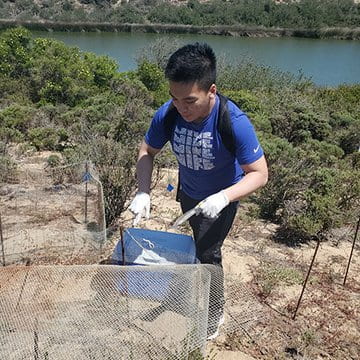
Frontier Fellow 2022-2023:
Peter Nguyen
Peter is an undergraduate student majoring in Ecology and Evolutionary Biology at the University of California, Santa Cruz. His research interests include conservation, plant ecology, and genomics. EFI is supporting Peter’s research project focusing on how climate change affects the growth and reproduction of the endangered Lupinus nipomensis. Peter is using eDNA techniques to identify potential microbial communities that may be supporting the species’ success during intensified climate scenarios and reintroduction efforts.
Peter says: “The fellowship provided me with the opportunity to work closely with Drs. Justin Luong, Van Wishingrad, Rachel Meyer, and Michael Loik at UCSC. Their guidance and mentorship were invaluable in shaping my research project and developing my skills as a researcher.”
Lupinus nipomensis is a low-growing herb that is native to California but is on the endangered species list – there is only one population of this species remaining in the world. Peter’s research took a census of microbial species in L. nipomensis soils using a technique called environmental DNA (eDNA) multilocus metabarcoding. Microhabitats are small-scale environments within a larger habitat where plants, animals, and microbes live in close contact. Peter compared the soil microbial communities at the field site at Guadalupe-Nipomo Dunes in southern coastal San Luis Obispo County with each other and with soils growing L. nipomensis in the UCSC greenhouses. He found that the microbial communities found in the field were more diverse and had more species compared to those in the greenhouse. The differences in species between different habitats or locations are referred to as “beta diversity.” The type of microhabitat had a significant impact on the types of soil organisms present, which affected the beta diversity, but whether L. nipomensis was reproductive at the time of the sampling did not have an effect. Contrary to expectations, nutrient-cycling microbes and diseases were abundant at the field site while nitrogen-fixing microorganisms were not. The team predicted that the soils in greenhouses and fields would have entirely different microbial compositions with no overlap, and this was confirmed. This poses a serious challenge to reintroducing endangered plants back into their natural habitats after being grown in a greenhouse. This research project used eDNA analysis, a novel tool for taking a census of organisms present in a habitat using one small soil or water sample. EDNA is becoming faster and cheaper and promises to be an important tool for conservation and restoration in future.
Peter presented his work at BOTANY 2022 and the California Native Plant Society meetings, where he networked with professors, students, land managers, and government agencies. He plans to submit his first paper to the American Journal of Botany in July 2023, present his full results at BOTANY 2023, and share his findings with the California Department of Fish and Wildlife and the land managers of San Luis Obispo. Peter’s hope is that this biomolecular method of species curation – eDNA – will promote innovative ecological management and research to conserve biodiversity for future generations.
Peter says: “This transformative experience has unequivocally strengthened my unwavering commitment to the preservation of biodiversity. With great enthusiasm, I am thrilled to announce that I have been accepted into the Quantitative and Systems Biology doctoral program at the University of California, Merced, where I will embark on my next academic endeavor this fall. During my Ph.D. studies, I intend to remain steadfast in my dedication to advancing molecular methods for biodiversity conservation and restoration. By employing cutting-edge techniques and leveraging interdisciplinary approaches, I aim to contribute to the development and refinement of innovative strategies in the field. By focusing on molecular methods, I strive to deepen our understanding of biological systems and their intricate dynamics, enabling more effective conservation efforts.


